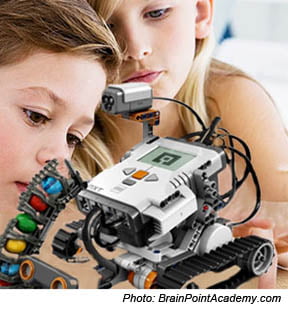Makerspaces in Your School?
By Greg Barrett, M.Ed, REFP / Educational Planner
Makerspaces are increasingly popular outlets for the Do It Yourself movement, and students and adults stand to learn a lot from them.
Defining Makerspaces
What is a makerspace, anyway? People can be judgmental. Librarian turned makerspace guru Diana Rendina posts on Renovated Learning that she was taken back by a comment that her library’s makerspace wasn’t real because it lacked power tools, pulling the plug – at least in the eyes of some – on its makerspace title. But are makerspaces really defined by what’s found inside them?
Though there are helpful lists for what would be good to have in makerspaces, like Makezine.com’s Makerspace Playbook, these are not completely prescriptive, because the “Do It Yourself” movement is less interested in telling you what to do, rather simply encouraging you to do it. School-based makerspaces thus have an array of disciplines to choose from, with educational benefits in tow for just about any one they choose.
Compare these to community makerspaces, ones that are winning grants and selling memberships to adults, ones that are undoubtedly trying to be the “real thing”; these makerspaces are not defined by the tools they have available. In fact, a celebrated part of the maker movement is how broad the set of skills and activities are for one to learn. Here in the Greater Boston Area alone, you can find makerspaces that run the gamut from textiles and sewing machines, to heavy-duty digital imaging and 3D printers. Do these spaces have every trade’s tools? No. Are all of them still makerspaces? You bet. Schools take note: you are free to make what you like.
The point of a makerspace is the ability to… you saw this coming… to make. Maker Media defines makerspaces as “Learning environments rich with possibilities that serve as gathering points where communities of new and experienced makers connect to work on real and personally meaningful projects, informed by helpful mentors and expertise, using new technologies and traditional tools.” This may be a more complete vision of their ideal making environment; one which schools are capable of offering.
School-Based Makerspaces
Empowered to design a makerspace in a school, we should ask ourselves a question: Why would anyone want a makerspace in a school at all? Is it necessary to have one in the school? It may be suitable to a school community for number of reasons.
…schools may be the only point of access to these skills….
Schools may be the only point of access to these skills and experiences to their student population and community more broadly. Makerspaces are not easy enterprises to start; they need space, materials, tools, utilities, members, and the list continues. Though many are funded through grants and memberships, there are many areas where access to creative, collaborative workspaces are simply unavailable. For many youngsters, that means these learning opportunities are only available at other schools or in other towns which may be out of reach. I think districts will increasingly find that they want to create these spaces not only to provide greater access, but because makerspaces align to some core concerns of 21st Century Learning.
Makerspaces support gobs of educational goals of a given school: interdisciplinary learning, collaborative learning, project-based learning, and active learning, just to name a few. Imagine history and science teachers coming together to study Nikola Tesla’s groundbreaking work in electricity with a joint project in the makerspace where looking for more ways to better connect to the community, as Anne O’Brien illustrates with a couple of example districts on Edutopia. A makerspace can be a wonderful conduit between schools and their communities. Plenty of people in a community have skills that they are willing to teach on a volunteer basis, plenty of others-–including students –-want to learn these skills. Bringing them together in a makerspace is a great way to foster community building.
At a recent DRA public visioning session, senior members of the community expressed excitement about the prospect of a space where they could possibly teach future students skills that they had learned at that very high school decades before. Students and community members might agree that these skills are still worth learning, and a makerspace can support that while also strengthening community bonds in a safe and useful common space.
If districts think that they would only like students to use a makerspace, opening that makerspace to the whole student body is a great peer-to-peer learning environment, especially if that student body is a district-wide, multi-aged group. Supervised, younger students learn from more relatable (i.e., cooler) and experienced older student-mentors, and these older students deepen their understanding through higher order thinking skills like explaining, demonstrating, and creating with subject matter. It’s a win-win for both students, not to mention that it is for the school as well.
 Makerspaces aren’t your father’s craft shop. They are wide ranging in discipline and built for creativity and innovation. That said, having a parent or two or other committed community members in your makerspace can add to the learning opportunities and community bonds in the school. Find out what gets your students excited, connect it to your curriculum, and see what happens when you supply the relevant tools, materials, and staff. From the looks of makerspaces that do these things, you may find students accomplishing some of their brightest ideas.
Makerspaces aren’t your father’s craft shop. They are wide ranging in discipline and built for creativity and innovation. That said, having a parent or two or other committed community members in your makerspace can add to the learning opportunities and community bonds in the school. Find out what gets your students excited, connect it to your curriculum, and see what happens when you supply the relevant tools, materials, and staff. From the looks of makerspaces that do these things, you may find students accomplishing some of their brightest ideas.
